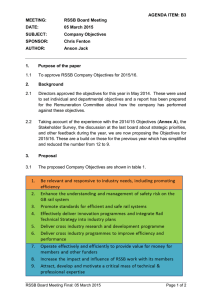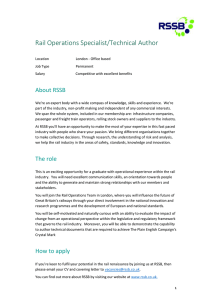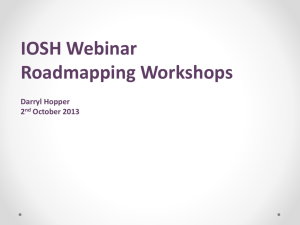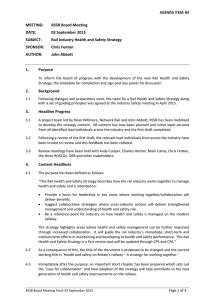Research Brief Management of health needs Introduction
advertisement
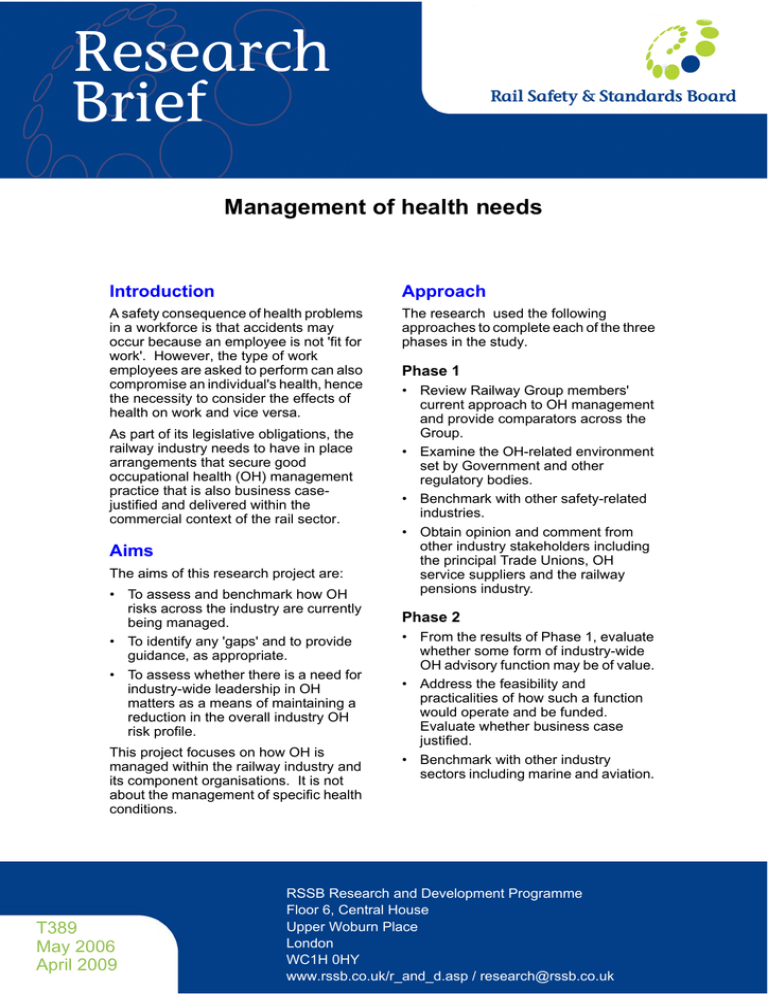
Research Brief Management of health needs Introduction Approach A safety consequence of health problems in a workforce is that accidents may occur because an employee is not 'fit for work'. However, the type of work employees are asked to perform can also compromise an individual's health, hence the necessity to consider the effects of health on work and vice versa. The research used the following approaches to complete each of the three phases in the study. As part of its legislative obligations, the railway industry needs to have in place arrangements that secure good occupational health (OH) management practice that is also business casejustified and delivered within the commercial context of the rail sector. Aims The aims of this research project are: • To assess and benchmark how OH risks across the industry are currently being managed. • To identify any 'gaps' and to provide guidance, as appropriate. • To assess whether there is a need for industry-wide leadership in OH matters as a means of maintaining a reduction in the overall industry OH risk profile. This project focuses on how OH is managed within the railway industry and its component organisations. It is not about the management of specific health conditions. T389 May 2006 April 2009 Phase 1 • Review Railway Group members' current approach to OH management and provide comparators across the Group. • Examine the OH-related environment set by Government and other regulatory bodies. • Benchmark with other safety-related industries. • Obtain opinion and comment from other industry stakeholders including the principal Trade Unions, OH service suppliers and the railway pensions industry. Phase 2 • From the results of Phase 1, evaluate whether some form of industry-wide OH advisory function may be of value. • Address the feasibility and practicalities of how such a function would operate and be funded. Evaluate whether business case justified. • Benchmark with other industry sectors including marine and aviation. RSSB Research and Development Programme Floor 6, Central House Upper Woburn Place London WC1H 0HY www.rssb.co.uk/r_and_d.asp / research@rssb.co.uk Phase 3 From the results of Phases 1 & 2: • Recommend the most appropriate arrangements for the delivery of effective corporate healthcare programmes for the railway industry at three levels: • Industry level arrangements, frameworks and systems • Organisational good practice • Practical guidelines on specific OH aspects common to most of the industry • Support Railway Group members in their work to comply with current legislation and meet appropriate UK and International Standards. Findings to date • Phase 1 was completed in September 2005 and the associated report is available on the RSSB web-site. • It contained 53 findings of which the most significant are listed below. OH Management in Railway Group Companies • The 'lead role' for OH was generally found to be with either the Safety or HR functions, with some companies having a joint lead role. • Over 90% of companies outsource 'medical' OH services, with all companies providing pre-employment screening, statutory medical provisions, stress and trauma counselling and support. • Formal 'Managing for Absence/ Attendance' processes were in place in nearly all the companies interviewed. Where rigorously applied, some companies had seen notable decreases in sickness absence. • The top OH related issues perceived as significant by the companies were: • Musculoskeletal Disorders (MSD) • Psychological illness (Stress) • Assault (Physical and verbal) • Biological hazards (e.g. needle stick injuries) (RSSB Project T382 researched the management of these issues in greater detail.) • Based on UK general industry average figures, the direct payroll cost of sickness absence across the rail sector is around ten times that of the total current expenditure on OH provision. • The cost of OH provision per employee per annum varied from less than £50 to greater than £150. There was some indication that increased spend resulted in decreased sickness absence. • Collecting, analysing and reporting on OH-related data was considered by the industry as being an area of some 'weakness'. • There was no discernable use of corporate Key Performance Indicators to monitor OH activities. Governmental & Regulatory Activity • There did not appear to be a consensus over where the OH leadership role should sit within the rail industry. • There were many and varied views strongly held around standards relating to medical fitness. There was a consensus, however, that many standards were in need of updating to reflect current medical developments and that cross referencing to obsolete standards should be corrected. • The research found that OH matters had low visibility within: • Industry guidance on the development of safety cases • Assessment criteria for safety case review and acceptance • Safety cases as currently operated • The national targets for health and safety within the Government's 'Revitalising Health and Safety Strategy' and the HSE 'Better Business' management tools were not generally found as featuring or influencing the work of Railway Group Member companies. OH Management Practice Non-Railway Sectors • A benchmark comparison of OH management practice between rail and non-rail sectors suggested that non-rail organisations were particularly strong in the following areas: • Line management ownership of OH • OH management information and reporting • National sickness absence levels below that for the rail sector (note: excludes consideration of the relative work environments) • The comparison found the rail sector Managing for Attendance activities to be as strong as the good practice examples found in non-rail. Next Steps The key contents of this research were presented at a Seminar Managing Health and Safety in the Rail Industry, which was held in London in June 2006. Copies of the guidance notes from this work were distributed at the Seminar and are still available from RSSB. On that occasion the industry representatives present agreed that there was a need to collect and analyse data about health conditions and their impacts in order to provide tools to help manage health risk to rail industry employees. A follow-on project T823 Management of health conditions and diseases has subsequently been completed. Contact Michael Woods Head of Operations Research Research and Development Programme Rail Safety and Standards Board research@rssb.co.uk


